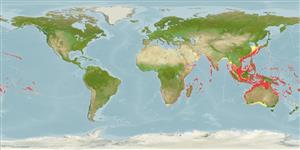Actinopterygii (ray-finned fishes) >
Perciformes (Perch-likes) >
Carangidae (Jacks and pompanos) > Caranginae
Etymology: Caranx: French, carangue, the name of a Caribbean fish; 1836 (Ref. 45335).
Environment / Climate / Range
Ecology
Marine; brackish; reef-associated; depth range 10 - 188 m (Ref. 58302). Tropical; 26°C - 29°C, preferred 27°C (Ref. 107945); 35°N - 37°S, 19°E - 129°W
Indo-Pacific: Red Sea and east coast of Africa to the Hawaiian and Marquesan islands, north to southern Japan (Ref. 559) and the Ogasawara Islands, south to northern Australia. Hybrid with Caranx melampygus found in Hawaii (Ref. 58422).
Length at first maturity / Size / Weight / Age
Maturity: Lm 60.0 range ? - ? cm
Max length : 170 cm TL male/unsexed; (Ref. 9710); common length : 100.0 cm TL male/unsexed; (Ref. 5213); max. published weight: 80.0 kg (Ref. 4795)
Pelagic over sand and rock (Ref. 58302). Adults occur singly and inhabit clear lagoon and seaward reefs (Ref. 9710). They feed on crustaceans (like crabs and spiny lobsters) and fishes at night (Ref. 4887). Large individuals may be ciguatoxic. The largest trevally, reaching 1.7 m in length and a weight of over 60 kg (Ref. 48635). Spawning occurs on shallow seaward reefs and offshore banks (Ref. 37816). Juveniles are found in estuaries. Sold mostly fresh and dried salted.
Life cycle and mating behavior
Maturity | Reproduction | Spawning | Eggs | Fecundity | Larvae
Paxton, J.R., D.F. Hoese, G.R. Allen and J.E. Hanley, 1989. Pisces. Petromyzontidae to Carangidae. Zoological Catalogue of Australia, Vol. 7. Australian Government Publishing Service, Canberra, 665 p. (Ref. 7300)
IUCN Red List Status (Ref. 115185)
CITES (Ref. 94142)
Not Evaluated
Threat to humans
Reports of ciguatera poisoning (Ref. 9710)
Human uses
Fisheries: commercial; aquaculture: commercial; gamefish: yes; aquarium: public aquariums
Tools
Special reports
Download XML
Internet sources
